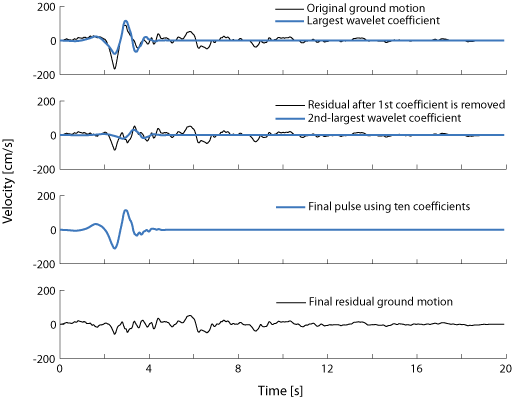Quantitative classification of pulse-like ground motions
Additional details and software regarding this project are provided here.

Figure from Baker, 2007
Ground motions with velocity pulses caused by near-fault directivity have received a great deal of attention from engineers and seismologists because of their potential to cause severe damage to structures. Many studies have investigated the dynamic response of structures to these "pulse-like" ground motions, but the ground motions are typically identified using judgment rather than some classification procedure. The lack of a systematic, quantitative classification scheme has hindered progress in answering even seemingly simple questions such as the probability that a ground motion with a given magnitude, distance and source-site geometry will have a velocity pulse. In this project, a quantitative scheme for detecting pulses is being developed. The procedure uses a wavelet-based signal decomposition to identify and extract the largest velocity pulse from a ground motion, and if the extracted signal is large relative to the remaining signal, the ground motion is classified as a pulse-like motion. The identified pulse-like ground motions are then being used in dynamic nonlinear structural analyses to identify relationships between near-fault directivity effects and structural response.
Selected publications:
| |
Burks, L. S., and Baker, J. W. (2016). “A predictive model for fling-step in near-fault ground motions based on recordings and simulations.” Soil Dynamics and Earthquake Engineering, 80(1), 119–126. |
| |
Shahi, S.K. and Baker, J.W. (2014). “An efficient algorithm to identify strong velocity pulses in multi-component ground motions.” Bulletin of the Seismological Society of America, 104(5), 2456–2466. Supplemental software tools and electronic supplement. |
| Burks, L. S., and Baker, J. W. (2014). “Fling in near-fault ground motions and its effect on structural collapse capacity.” Proceedings of the Tenth U.S. National Conference on Earthquake Engineering, Anchorage, Alaska, 10p. | |
|
|
Spudich, P., Rowshandel, B., Shahi, S. K., and Baker, J. W. (2014). “Overview and Comparison of the NGA-West2 Directivity Models.” Earthquake Spectra, 30(3), 1199–1221. |
| Spudich, P., Bayless, J., Baker, J. W., Chiou, B. S. J., Rowshandel, B., Shahi, S. K., and Somerville, P. G. (2013). Final Report of the NGA-West2 Directivity Working Group. Pacific Earthquake Engineering Research Center, Report 2013/09, Berkeley, CA, 131p. | |
| Baker, J. W., Bozorgnia, Y., Di Alessandro, C., Chiou, B. S. J., Erdik, M., Somerville, P. G., and Silva, W. J. (2012). “GEM-PEER Global GMPEs Project Guidance for Including Near-Fault Effects in Ground Motion Prediction Models.” Proceedings of 15th World Conference on Earthquake Engineering, Lisbon, Portugal, 10p. | |
| Spudich, P., Watson-Lamprey, J., Somerville, P. G., Bayless, J., Shahi, S. K., Baker, J. W., Rowshandel, B., and Chiou, B. S. J. (2012). “Directivity models produced for the Next Generation Attenuation West 2 (NGA-West 2) project.” Proceedings of 15th World Conference on Earthquake Engineering, Lisbon, Portugal, 9p. | |
| Shahi, S., and Baker, J. W. (2011). “An empirically calibrated framework for including the effects of near-fault directivity in probabilistic seismic hazard analysis.” Bulletin of the Seismological Society of America, 101(2), 742-755. | |
| Shahi, S. K., and Baker, J. W. (2011). “Regression models for predicting the probability of near-fault earthquake ground motion pulses, and their period.” 11th International Conference on Applications of Statistics and Probability in Civil Engineering, Zurich, Switzerland, 8p. | |
| Shahi, S. K., and Baker, J. W. (2010). “Signal Processing and Probabilistic Seismic Hazard Analysis Tools for Characterizing the Impact of Near-Fault Directivity.” Proceedings, 7th International Conference on Urban Earthquake Engineering (7CUEE) & 5th International Conference on Earthquake Engineering (5ICEE), Tokyo, Japan, 6p. |
|
| Green R.A., Lee J., White T.M., and Baker J.W., (2008) The significance of near-fault effects on liquefaction, 14th World Conference on Earthquake Engineering. Beijing, China. 8p. | |
| Baker J.W. (2008). Identification of near-fault velocity pulses and prediction of resulting response spectra, in Geotechnical Earthquake Engineering and Soil Dynamics IV, Sacramento, California, 10 pp. | |
| Baker J.W. (2007). Quantitative classification of near-fault ground motions using wavelet analysis, Bulletin of the Seismological Society of America, 97 (5), 1486-1501. | |
| Tothong P., Cornell C.A., and Baker J.W. (2007). Explicit directivity-pulse inclusion in probabilistic seismic hazard analysis, Earthquake Spectra, 23 (4), 867-891. |